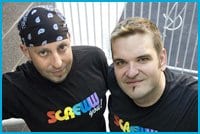For generations of Toronto’s queer youth, Tuesday evenings at the 519 Community Centre were a lifeline. It was there, sitting in a circle with other queer and questioning kids in The 519’s auditorium, that many teens were able to talk about things they couldn’t share with family or friends — some, for the first time in their lives.
Lesbian Gay Youth Toronto (LGYT), which later became Lesbian Gay Bisexual Youth Toronto (LGBYT) and then WAYV (Welcoming All Youth to the Village), was a refuge for youth for nearly 30 years. The group folded last year because of low attendance.
“When I found out the group was gone I felt a profound expression of loss,” says Ralph Hamelmann, a former LGYT coordinator. “I moved to Toronto 20 years ago, and when I first got here I found LGYT. I just can’t stress how much of an important institution this was to many people.”
The group, affectionately known as “gay high school” to its regulars, had thousands of members since it was founded in the late 1970s. Entirely volunteer run, the peer support group offered an opportunity for queer youth to come out to one another, forge their first gay friendships and explore issues such as coming out, homophobia and safer-sex education.
Hamelmann, who is also the organizer of the regular retro party Screww, is honouring the group with a reunion edition of the popular party on Fri, Aug 17 at Buddies in Bad Times Theatre. A Facebook group Hamelmann founded to help former members reconnect is also up and running with great success.
“I thought it would be fun to get together with the people I was with, the 1987-’89 crowd. Then I thought about including all the other alums over the years, of which more than 100 have already signed up. There’s been a lot of interest in the party, especially now since they learned the group had folded. People are thinking of the impact it had on their lives.”
Kristyn Wong-Tam, a real estate broker and coowner of Xexe Gallery, was involved as a newcomer facilitator and also with the group’s lesbian caucus from 1988 to 1990. She says she remembers clearly collecting enough courage to attend LGYT as a 16-year-old nearly 20 years ago.
“I had initially found out about the Tuesday meetings… from a small classified community listing in Now magazine,” says Wong-Tam. “I had clipped it out and folded it into a tiny, little square and buried it into the corner crevices of my wallet, scared to death that someone would find it.
“Walking into The 519 auditorium and seeing other young kids… was electrifying and nerve-wracking all in the same emotional breath. Knowing that I was no longer alone and that I belonged to a larger community alleviated many of my social insecurities.”
Wong-Tam left LGYT two years later to start a lesbian youth group called Lesbian Youth Peer Support (LYPS), for which she says she borrowed many of the ideals of youth mentorship and empowerment from LGYT.
“To this day I feel indebted to those who founded the group and know that I would not be the person I am without the many experiences and wisdom learned from being a member of LGYT.”
Adrian R Betts is the director of marketing and fund development at the AIDS Network. He was an LGYT coordinator and newcomer facilitator between 1985 and 1988. Betts says the group was quite political in his day and was ready to take issues head-on. At one point they organized a pro-gay march to Washington.
Betts says that there was a huge need for a group like LGYT in the 1980s.
“Back then it was different,” he says. “There weren’t resources available like the internet. Coming out is now much more acceptable than it was back then. We were getting calls from teenagers who were trying to commit suicide. We were literally saving lives.”
In addition to changes in societal attitudes that have made it easier for queers to come out over the years, WAYV membership also diminished thanks to the increase in staff-supported services for young queers, including Supporting Our Youth (SOY).
“I think that a lot of WAYV members started going over to SOY,” says 519 office manager Helen Rykens, who saw the group flourish for years, before folding in 2006. “At the end, WAYV had so few members, maybe down to 10 and there was no one who was in a position to take on a leadership role to keep things going. I also think it was a natural progression… with the new building and the fact that SOY was offering more and more programs.”
But at least some former members would like youth to have both options.
“I think that SOY has a lot of good programs but it would be great to have an additional group for youth, run by youth,” says Hamelmann.
“I think that there are enough diverse needs among LGBT [lesbian, gay, bisexual, trans] youth that there should be several forums for them to choose from,” says Wong-Tam. “I can appreciate that there are new social technology platforms for youth to network in but it can never replace the need for real human interaction and connection. That’s why I think that SOY and groups like WAYV should not be exclusive from one another. After all, can you imagine the collaboration and innovation opportunities that would exist if these groups were able to flourish and supported one another?”

 Why you can trust Xtra
Why you can trust Xtra


